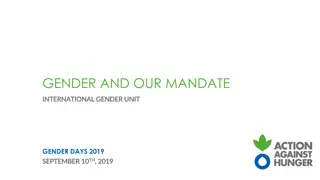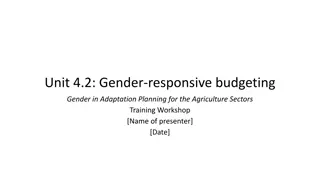Gender Disparities in Primary Teaching Career Progression: Insights from INTO Equality Committee
The impact of gender on career progression in primary teaching has been a longstanding concern, as highlighted by the INTO Equality Committee. Established nearly thirty years ago, the Committee aims to achieve pay parity between male and female teachers. Recent themes include addressing workplace bullying, promoting inclusion in the teaching profession, focusing on mental health, and exploring religion and ethos in primary schools. Insights from surveys and focus groups reveal persistent gender imbalances and challenges faced by teachers, particularly regarding family leave, promotions, and perceptions of the principal role. The breakdown of survey respondents indicates a predominantly female representation in the profession, with a wide age demographic reflecting the teaching workforce today.
Download Presentation

Please find below an Image/Link to download the presentation.
The content on the website is provided AS IS for your information and personal use only. It may not be sold, licensed, or shared on other websites without obtaining consent from the author.If you encounter any issues during the download, it is possible that the publisher has removed the file from their server.
You are allowed to download the files provided on this website for personal or commercial use, subject to the condition that they are used lawfully. All files are the property of their respective owners.
The content on the website is provided AS IS for your information and personal use only. It may not be sold, licensed, or shared on other websites without obtaining consent from the author.
E N D
Presentation Transcript
The impact of gender on career progression in primary teaching
INTO Equality Committee The Committee was established almost thirty years ago, with the goal of achieving pay parity between male and female teachers. In 1988, the first report of the Equality Committee was presented to INTO Congress. Themes of recent Equality Conferences have included 2007 Tackling Workplace Bullying: Dignity in the Workplace 2010 F ilte Inclusion in the Teaching Profession 2013 Mental Health and Teaching, and Religion and Ethos in Primary Schools
Pamphlet published by INTO in 1989
A 27 year old pamphlet, myths versus reality but how much has changed?
Background Statistics indicated a gender imbalance. Committee conducted focus groups in 16 districts after October Branch Meetings. Topics raised by members included: Impact of taking family leave, and other caring responsibilities, Moratorium on promotions, The role of principal being unattractive and poorly remunerated.
In April 2016, 1,000 electronic surveys were sent to randomly selected members in the Republic of Ireland, and to 300 members in Northern Ireland. Response rate in the Republic was 18%, but only 5% for Northern Ireland. As such, the Northern Irish responses were not felt to be fairly representative, and were not used for the final report.
Who responded? Gender breakdown of survey respondents Survey respondents were 14% male and 86% female, which is broadly representative of the profession nationally. 15% Female Male 85%
Age of Respondents Female Male All 25 years or less 26 40 years 41 50 years Over 50 years 7% 53% 14% 26% 11% 58% 4% 27% 8% 53% 12% 27% Respondents included teachers of all ages, with over 61% aged 40 or under. Teachers in the over 40 age groups who responded to the survey totalled 39%. Respondents reflect the age demographic in teaching today. The survey should be seen to represent a very wide range of teachers.
Gender of all teachers v. principals Gender breakdown of ROI Primary Teachers (DES figures, 2014) Gender breakdown of ROI Primary Principals (2012) 14% 35% 65% 86% Female Male
Respondents school size School size 1 11 teachers 12 16 teachers 17+ teachers Female 35% 17% 48% Male 19% 23% 58%
Promoted posts were held by 41%of all respondents, 52% of male respondents, 38% of female respondents.
Breakdown of promoted post holders Post held Female Male All Respondents Principal Deputy Principal 25% 27% 57% 14% 31% 24% Special Duties Post Holder 31% 22% 28% Assistant Principal 14% 0% 12% Privileged Assistant 3% 7% 5%
Where do the respondents teach? Male Respondents Female Respondents Urban schools 5% 4% 7% 8% Rural schools 38% 17% 23% DEIS Schools 54% Special Schools 11% 33% Gaelscoileanna
Internal versus External Appointments to Principal 75% 25% 25% 25% 53% 53% 47% 53% Internal applicants External applicants
UK research in 2008 indicated three times as many female as male head teachers had been appointed internally. Reasons suggested included: The weight of caring responsibilities on women Women had less mobility than male colleagues A lack of self confidence No Job for a Woman, NASUWT report, 2008
Department of Education figures in 2012 showed women earned an average salary of 53,766.75, while men earned 58,040.59.
Attitudes to career I am very ambitious. 64% of female respondents agree, 81% of males agreed.
Teaching was always my main career goal. 68% of female respondents agreed, 77% of males agreed.
I am enthusiastic about teaching. 93% of female respondents agreed, 96% of males agreed.
Family Leave 48% of female respondents had taken maternity leave 14% of female respondents had taken parental leave, where 4% of male respondents had availed of this leave 5% of female respondents had taken carers leave, whereas no men indicated they had taken this leave.
36% of all respondents had taken Family Illness Leave, with 39% of female respondents having taken it, as opposed to 24% of male respondents. 13% of female respondents had availed of the job sharing scheme, and no men indicated that they had job shared.
Being female is not a hindrance to promotion and as a parent I think current maternity leave is totally ridiculous far too long no one could run a business and pay for so much time off. Female teacher, aged over 50, in a rural school.
Family life is my priority. 72% of female respondents agreed, 69% of males agreed.
Teaching allows for a good work-life balance. 67% of female respondents agreed, 65% of males agreed.
23% of female respondents had taken a career break, as opposed to 15% of male respondents. The reasons given were: Females Males All respondents Travel 38% 50% 38% Caring responsibilities 21% 0% 21% Other 20% 25% 20% Non-teaching job 9% 25% 10% Study 9% 0% 8% Illness 3% 0% 3%
Taking time off to care for family would impact negatively on my career. 34% of females respondents agreed with this statement, as did 31% of males.
Taking up the principalship of my school would impact negatively on my family life. 75% of females respondents agreed with this statement, as opposed to just 56% of males.
Perceived barriers to leadership ambitions Workload was seen as the greatest barrier to leadership aspirations overall. When considering the top ten perceived barriers of both genders, workload and availability of suitable posts are identified as the two most significant barriers. Caring and family responsibilities was ranked third by female respondents, but eighth by male respondents.
I acted as Principal for a year. It put me off the job for life. I feel that the job is unattractive to teachers of any gender. Male teacher, aged over 50, in an urban school
Previously experienced teachers and vice principals. Now these teachers are reluctant to apply, and the posts are going to inexperienced young men eager for promotion in a time with no promoted posts. This causes resentment and problems within schools. There are so few teachers now in their fifties and sixties that they are not valued by colleagues or parents. most promotions to principals were Female teacher, aged 41-50, in a rural school
Top ten barriers to career progression ranked By female respondents 1 Workload By male respondents Workload Availability of suitable posts Availability of suitable posts 2 Caring or family responsibilities My age 3 Self-confidence Qualifications and experience 4 Recruitment policies and procedures Self-confidence 5 My age Recruitment policies and procedures 6 Qualifications and experience Attitude of senior colleagues 7 Attitude of senior colleagues Caring or family responsibilities 8 Access to leadership programmes Access to leadership programmes 9 Taking a career break, or maternity or parental leave My age of entry into the profession 10
I feel as a male in a female dominated industry there is a massive lack of promotion of male teachers both inside and out of the profession. With 5 to 1 rates of female to male teachers in our education system it is an outrage there is not more being done to encourage males into this profession. Male teacher, aged 26 40, in an urban school
Perceived enablers to achieve leadership ambitions Two factors overwhelmingly identified as the most important enablers: change in role of principal less bureaucracy, and a reduced workload and an improved work/life balance. More opportunities were ranked third by female respondents, while more support from leaders/management was ranked third by male respondents.
Where to now? The INTO Equality Committee recognises that there is both a gender imbalance in career progression, but also more broadly in the teaching profession. In your discussion groups consider: What might be the reason for these imbalances? Can we address the gender imbalance in teaching overall? Can we, as teachers and INTO members, make leadership more attractive to female teachers? Gendered perceptions of equal opportunities in the appointment process, and career progression.























